Live streaming has become an essential tool for content creators, businesses, and influencers to engage with their audiences in real-time. No matter what type of creator you are, choosing the right platform can make or break your streaming success. With countless options available, each with its own unique features and pricing, finding the perfect fit can be overwhelming. This article will guide you through the 12 best live streaming platforms in 2024, providing insights to help you make an informed decision.
What is a Live Streaming Platform?
A live streaming platform is a digital service that enables users to broadcast live video content to an audience in real-time over the internet. These platforms are designed to facilitate the seamless streaming of video, often with additional features such as chat functionalities, monetization options, and integration with social media networks. Live streaming platforms are used for a variety of purposes, including gaming, social interaction, education, business, and entertainment. They allow creators to engage directly with their audience, offering a dynamic and interactive experience that pre-recorded content cannot match. With advancements in technology, these platforms have evolved to support high-definition video, low-latency streaming, and multi-platform distribution, making live streaming more accessible and effective for creators of all kinds.
The 12 Best Live Streaming Platforms
Social Media Live Streaming Platforms
1. YouTube Live
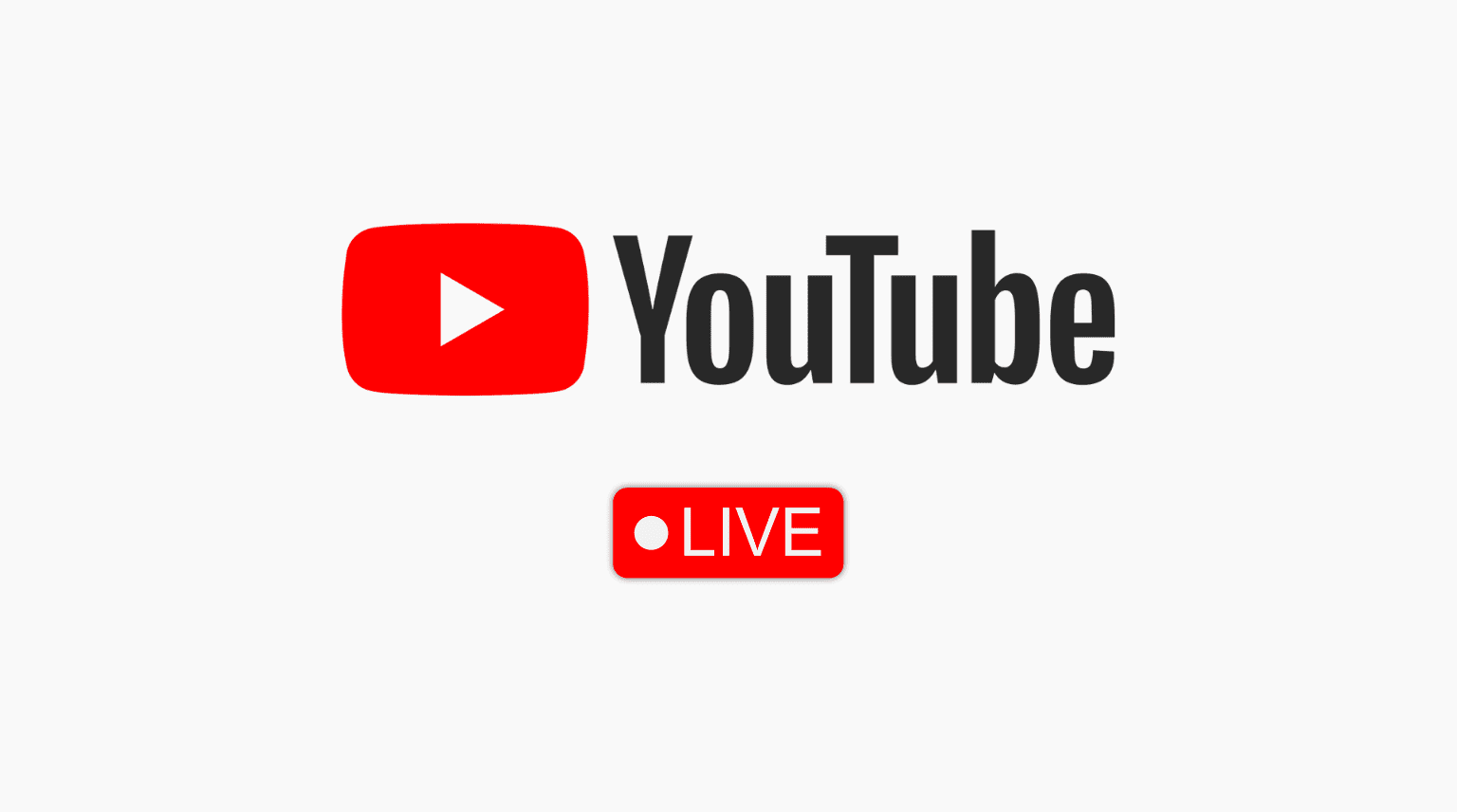
YouTube Live is part of the broader YouTube platform, which is the second most visited website in the world. Launched in 2011, YouTube Live allows users to broadcast content in real-time to a global audience. It’s particularly favored by creators across various niches, including gaming, education, entertainment, and more. With YouTube Live, users can schedule live streams, engage with their audience through live chat, and monetize their streams via ads, Super Chat, and channel memberships. The platform supports high-definition streaming and offers robust analytics, making it a go-to choice for both casual streamers and professional content creators.
Pricing: Free
Pros:
- Extensive audience reach due to YouTube’s large user base.
- Monetization options through ads, Super Chat, and channel memberships.
- High-quality streaming with 4K support.
- Easy integration with Google services and YouTube’s content management.
Cons:
- Requires meeting certain eligibility criteria to live stream.
- Heavy competition can make it difficult to stand out.
- Limited customization compared to other platforms.
2. Twitch
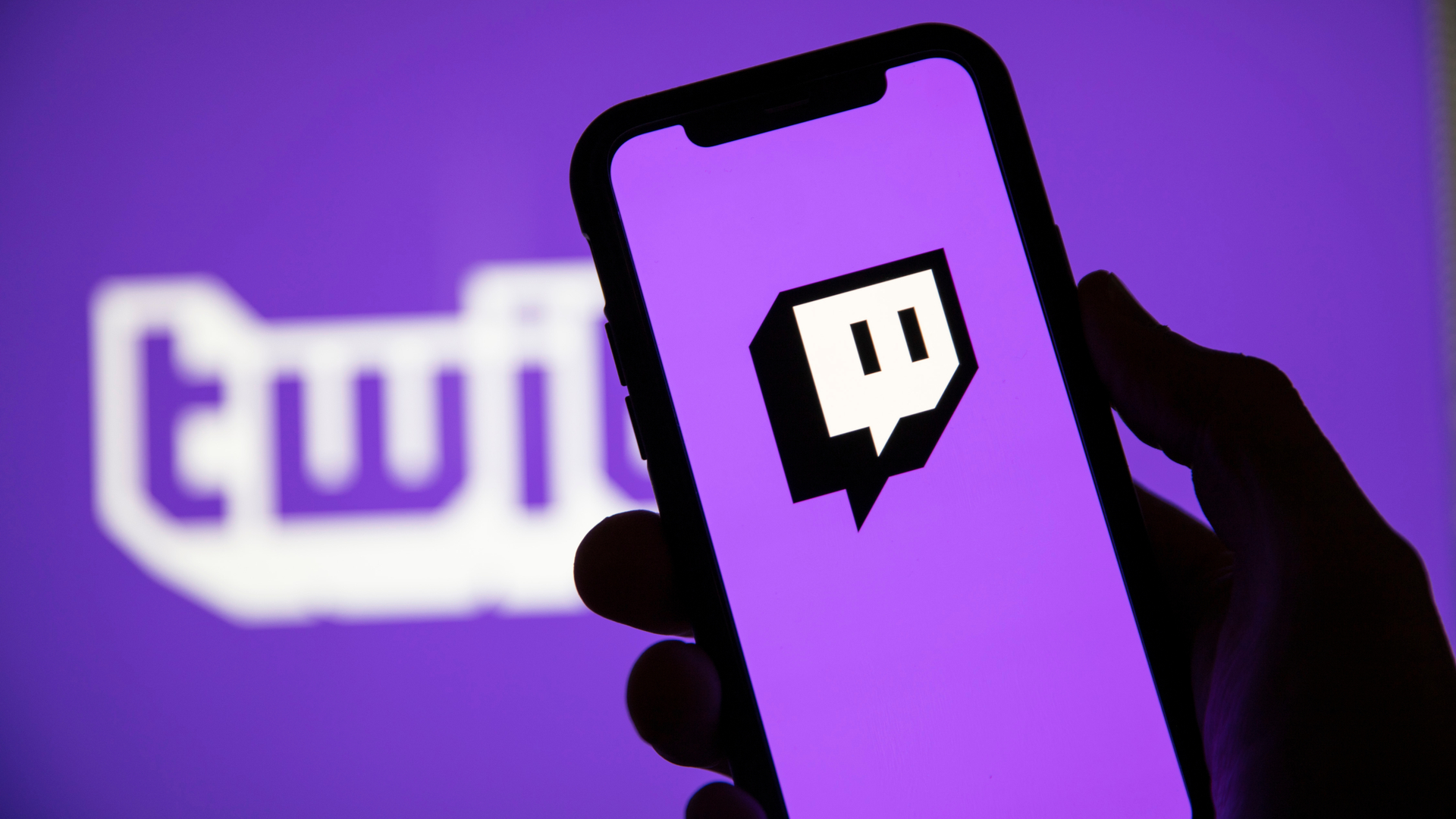
Twitch, launched in 2011 and acquired by Amazon in 2014, is the leading platform for live streaming, especially within the gaming community. It allows users to broadcast their gameplay, engage with viewers through real-time chat, and build communities around specific games or content genres. Over the years, Twitch has expanded to include various non-gaming content, such as music, talk shows, and creative arts. It supports monetization through subscriptions, bits (a form of virtual tipping), and ads. Twitch’s community-driven approach, coupled with extensive customization options, makes it a favorite among gamers and content creators seeking to build a loyal following.
Pricing: Free
Pros:
- Strong community engagement with real-time chat features.
- Monetization through subscriptions, bits, and ads.
- Customizable stream layout and extensions.
- Active support for content creators, including partnerships and affiliate programs.
Cons:
- Primarily focused on gaming, making it challenging for non-gaming content to thrive.
- Strict content guidelines.
- High competition among streamers.
3. Instagram Live
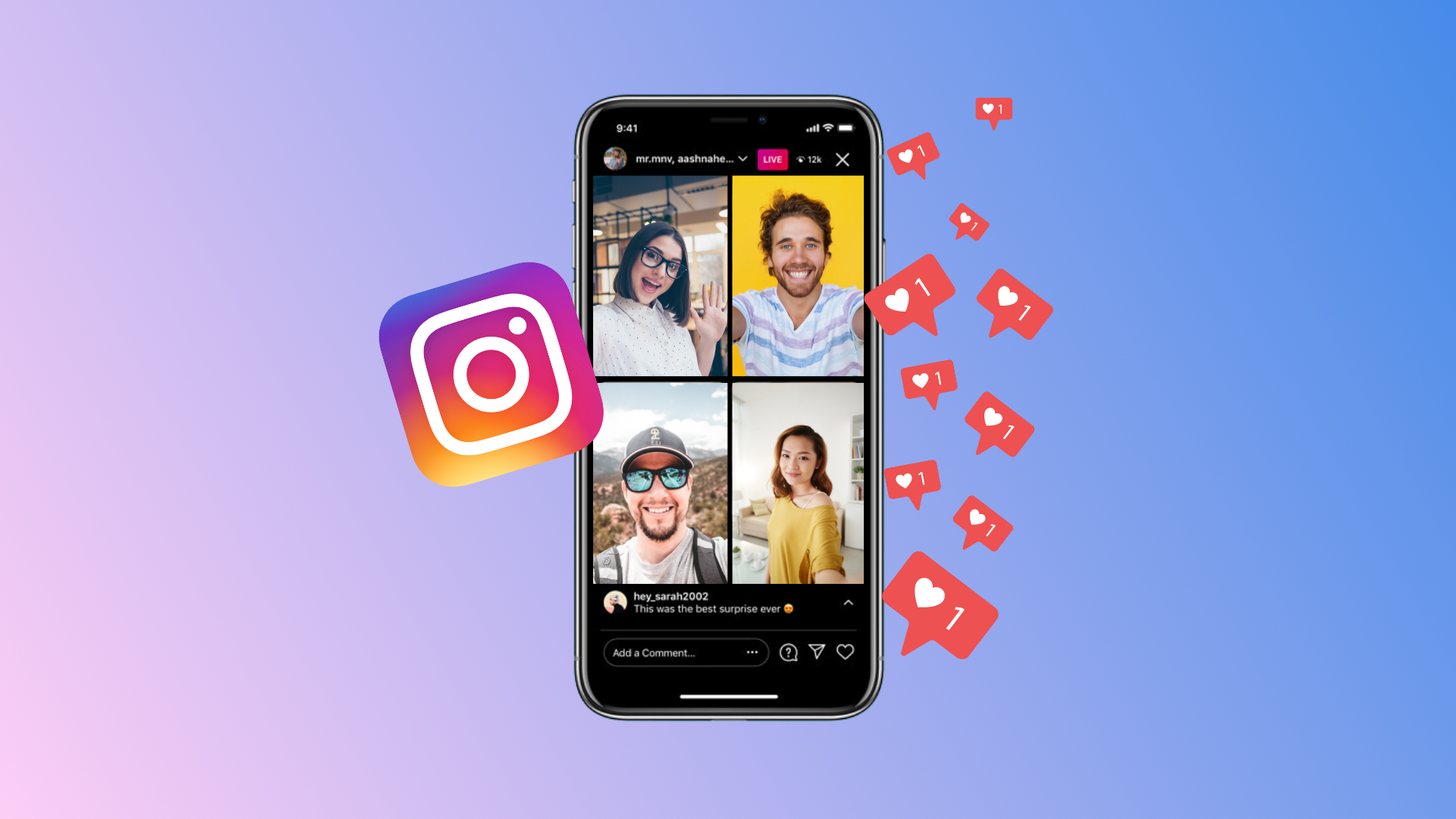
Instagram Live is a feature of Instagram, a platform owned by Meta (formerly Facebook), that allows users to broadcast live video to their followers. Launched in 2016, Instagram Live is seamlessly integrated into the Instagram app, making it easy for users to go live directly from their mobile devices. It’s particularly popular among influencers, brands, and celebrities for its interactive capabilities, such as live comments, questions, and the ability to invite viewers to join the stream. Instagram Live also allows users to save their broadcasts as Stories, giving them 24 hours of additional visibility. The platform’s mobile-first approach and integration with Instagram’s broader social media ecosystem make it ideal for casual, on-the-go streaming.
Pricing: Free
Pros:
- Direct engagement with followers via real-time comments and questions.
- Integrated into Instagram’s social media platform, enhancing visibility.
- Option to save and share live videos as Instagram Stories.
- Easy to go live without needing advanced equipment.
Cons:
- Limited to mobile streaming.
- No direct monetization options for live streams.
- Limited in terms of stream customization and analytics.
4. TikTok Live

TikTok Live is a feature within TikTok, the fast-growing social media app known for short-form video content. Launched in 2019, TikTok Live allows users to broadcast live to their followers, engaging them with real-time interaction. The platform is especially popular among younger audiences and content creators looking to leverage TikTok’s powerful algorithm for increased discoverability. TikTok Live includes features like live gifting, where viewers can send virtual gifts that can be converted into real money. The platform’s focus on creativity and interactivity, combined with its large and active user base, makes TikTok Live an appealing option for influencers and brands seeking to reach a younger demographic.
Pricing: Free
Pros:
- High engagement rates, especially among younger users.
- Interactive features like Q&A, gifting, and polls.
- Easy to go live directly from the mobile app.
- Strong algorithm-driven discoverability.
Cons:
- Limited monetization options outside of gifts.
- Must meet follower and age requirements to access live streaming.
- Limited stream duration and lack of advanced streaming features.
5. Facebook Live
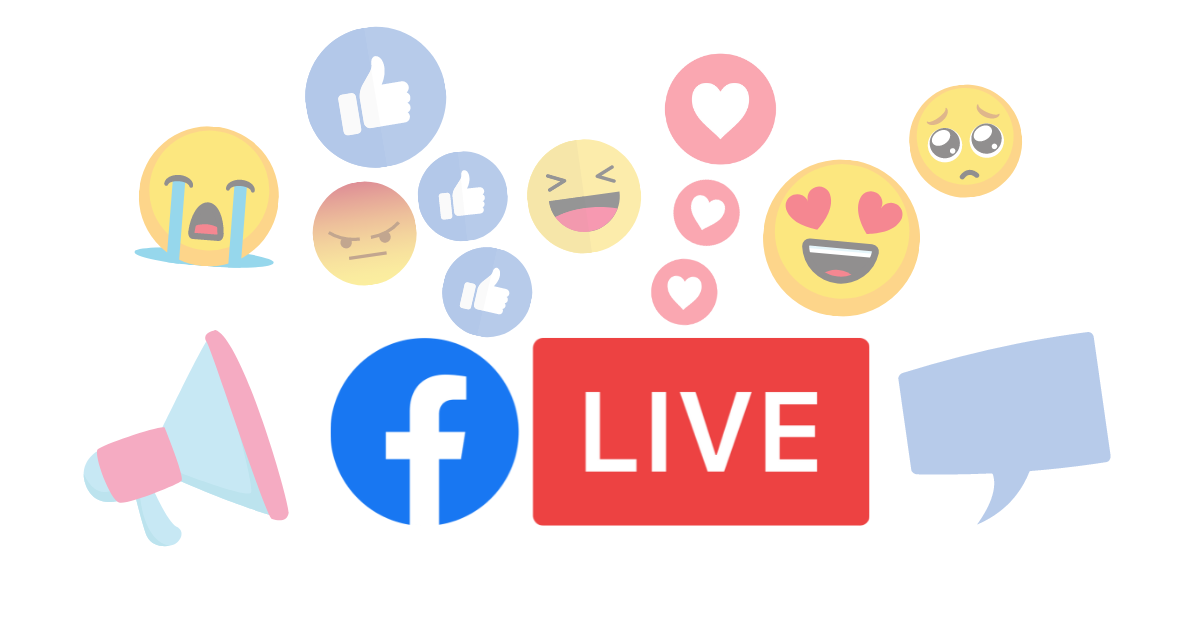
Facebook Live, launched in 2016, is a live streaming feature within Facebook, one of the largest social media platforms globally. It allows users to broadcast real-time video to their friends, followers, or the public. The platform is widely used for personal updates, brand promotions, events, and community engagement. Facebook Live’s integration with Facebook’s social networking features enables streamers to reach a broad audience, interact through live comments and reactions, and share their streams across the platform. Additionally, streams can be saved as video posts, allowing for ongoing engagement after the broadcast ends. With its extensive reach and user-friendly interface, Facebook Live is a versatile tool for both individuals and businesses.
Pricing: Free, with optional paid promotions.
Pros:
- Large user base with global reach.
- Interactive features like live comments, reactions, and polls.
- Easy to share and promote live streams on the platform.
- Ability to save and archive live videos.
Cons:
- Limited monetization options.
- Requires adherence to Facebook’s strict content policies.
- Potential reach limitations due to Facebook’s algorithm.
6. LinkedIn Live
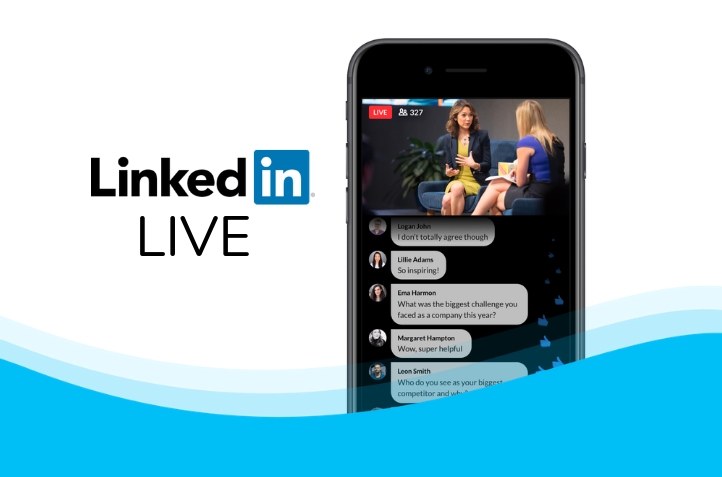
LinkedIn Live is a live streaming feature of LinkedIn, the world’s largest professional networking platform. Launched in 2019, LinkedIn Live is designed for professionals and businesses to broadcast content to their network. It’s particularly popular for webinars, panel discussions, product launches, and industry-specific content. LinkedIn Live allows users to reach a targeted, professional audience, making it ideal for B2B marketing, thought leadership, and brand building. The platform offers engagement features like live comments and reactions, and streams can be shared within the LinkedIn community for extended reach. LinkedIn Live’s focus on professional content and its integration with LinkedIn’s networking tools make it a powerful platform for business-oriented live streaming.
Pricing: Free
Pros:
- Access to a professional audience.
- Ideal for B2B marketing, networking, and thought leadership.
- Integration with LinkedIn’s analytics and professional tools.
- Ability to build credibility and authority in your industry.
Cons:
- Requires an application to access LinkedIn Live.
- Limited to professional or industry-specific content.
- Fewer customization options compared to other platforms.
Paid Online Stream Platforms
1. Dacast
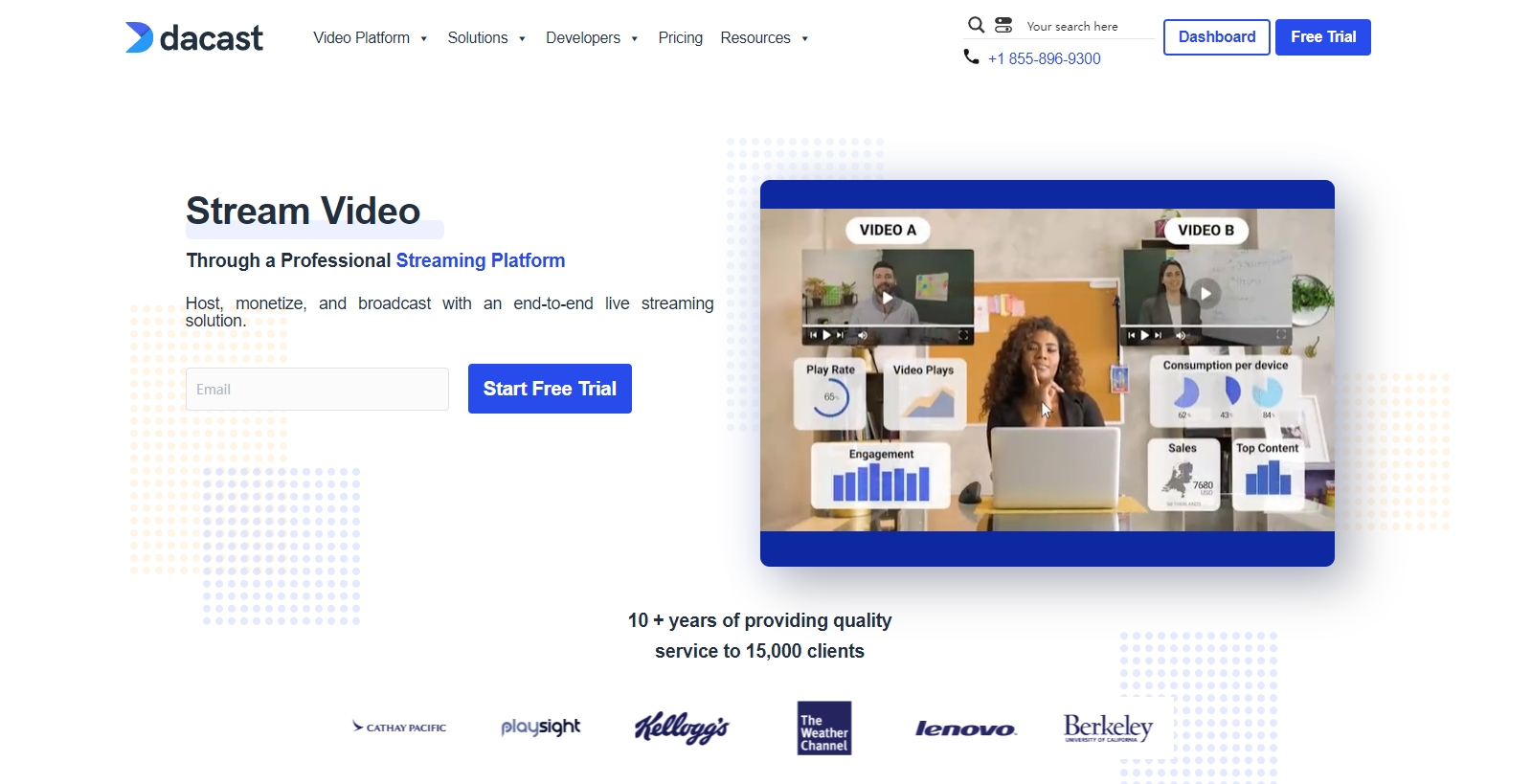
Dacast is a professional-grade live streaming platform that offers both live and on-demand video streaming services. Founded in 2008, Dacast is known for its robust, feature-rich platform that caters to businesses, educational institutions, and broadcasters. Dacast provides a white-label solution, allowing users to fully brand their streams without any third-party branding. The platform supports various monetization options, including pay-per-view, subscriptions, and ad insertion. It also offers advanced security features, such as password protection, geographic restrictions, and domain control. With its comprehensive analytics and high-quality streaming capabilities, Dacast is ideal for organizations looking to deliver professional, secure, and customizable live streaming experiences.
Pricing: Starts at $39/month for the Starter plan.
Pros:
- White-label streaming with no branding, offering full customization.
- Monetization options, including pay-per-view and subscriptions.
- Comprehensive analytics and viewer insights.
- High-level security features like password protection and geographic restrictions.
Cons:
- Steeper learning curve compared to simpler platforms.
- Higher cost, making it more suitable for businesses rather than individual streamers.
- Requires technical knowledge for advanced customization.
2. Vimeo Livestream
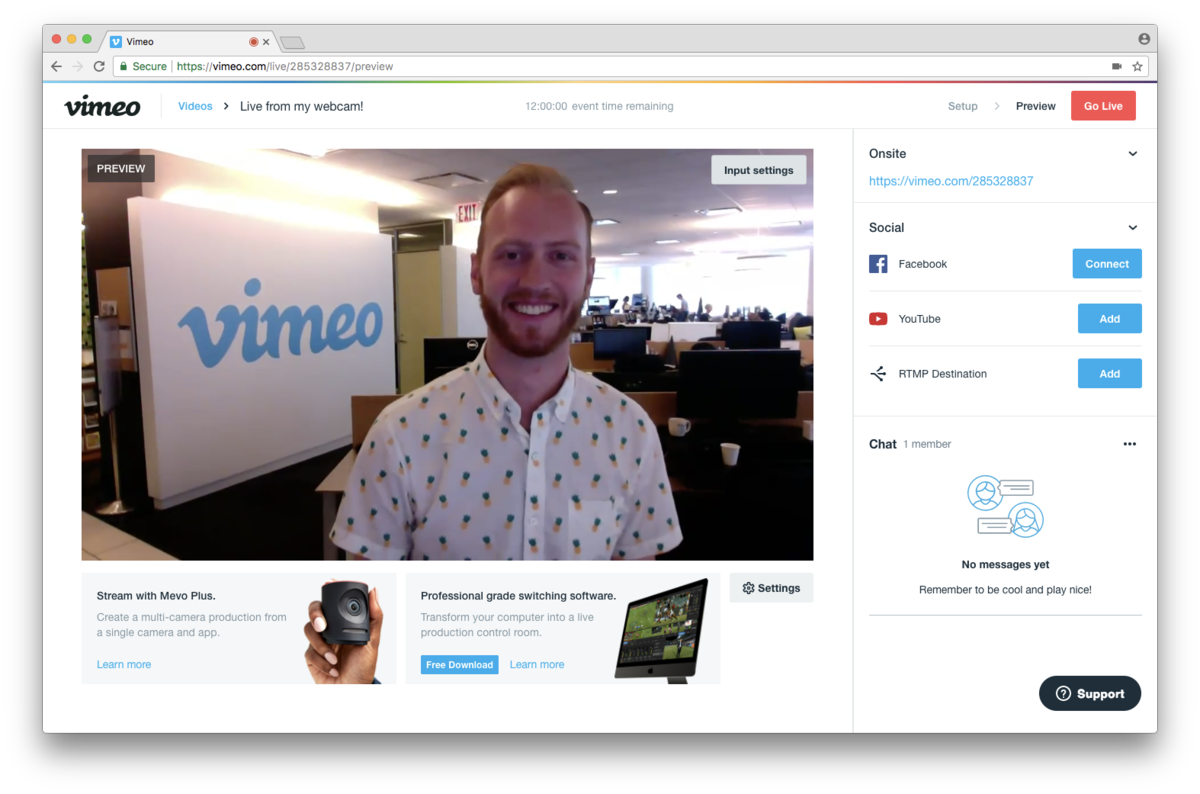
Vimeo Livestream is a professional live streaming platform that is part of Vimeo, a video hosting and sharing site known for its high-quality content. It acquired Livestream in 2017 and has since integrated its live streaming capabilities into its platform. This platform is favored by businesses, educational institutions, and event organizers for its high-definition streaming, customizable branding, and advanced privacy controls. The platform offers robust analytics, audience engagement tools, and seamless integration with Vimeo’s on-demand video services. Users can stream to multiple destinations simultaneously, including social media platforms, and monetize their streams through various options. Vimeo Livestream’s professional-grade features make it a top choice for high-quality live streaming.
Pricing: Starts at $75/month for the Premium plan.
Pros:
- Professional-grade streaming with high-quality video.
- Integration with Vimeo’s on-demand video services.
- Advanced analytics and detailed viewer engagement insights.
- Customizable branding and privacy controls.
Cons:
- High cost, making it less accessible for casual streamers.
- Limited social media integration.
- Requires a strong internet connection for optimal performance.
3. Muvi
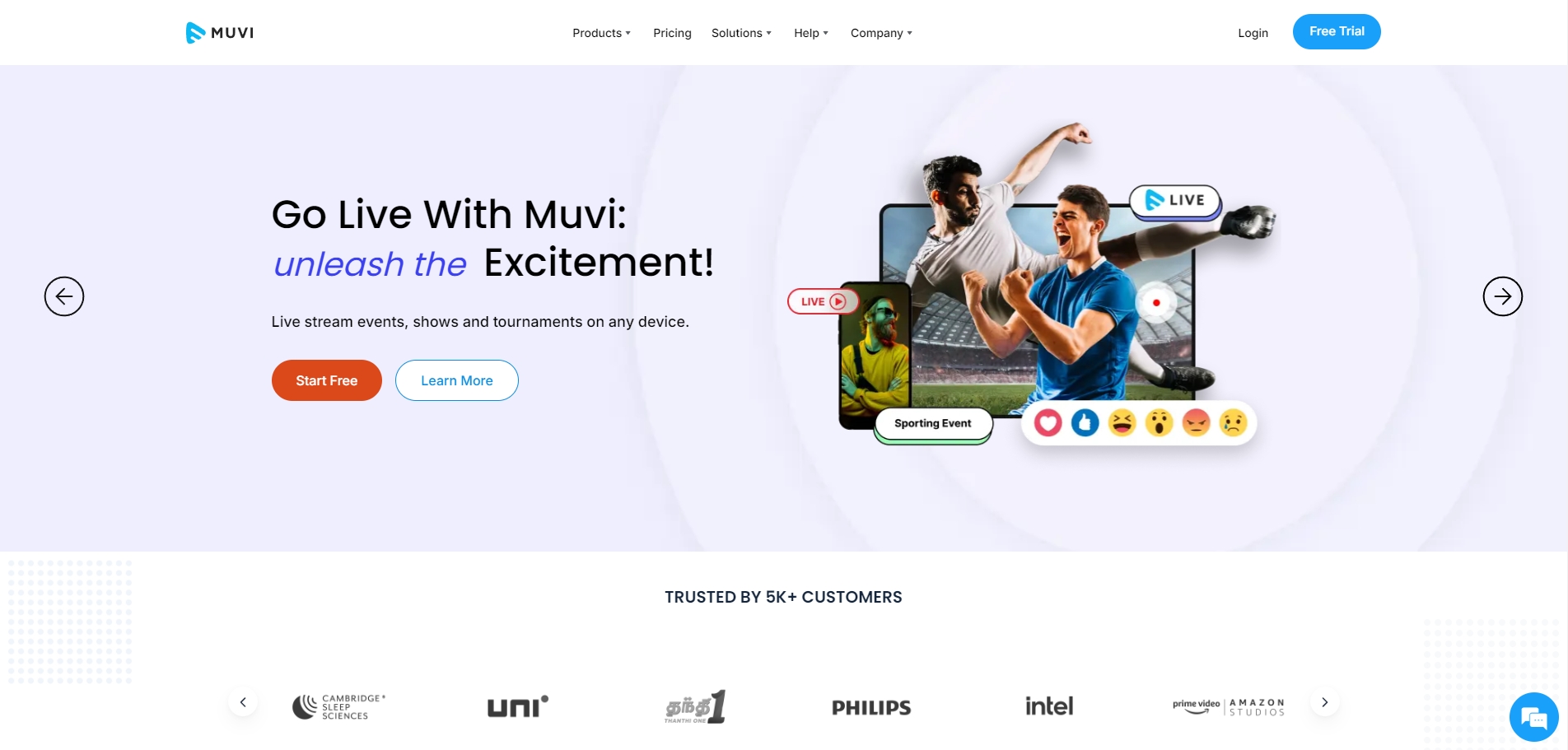
Muvi is an all-in-one streaming platform that provides live streaming, video-on-demand, and OTT (Over-the-Top) services. Founded in 2013, Muvi is known for its flexibility and comprehensive feature set, which includes everything from video hosting to monetization and analytics. Muvi’s white-label solution allows users to create fully branded streaming services without any third-party interference. The platform supports multiple monetization models, including subscriptions, pay-per-view, and ads, and it’s compatible with various devices and platforms. Muvi’s scalability and extensive customization options make it suitable for businesses of all sizes, from startups to large enterprises. Whether for live events, corporate communications, or entertainment, Muvi offers a robust solution for delivering and monetizing content.
Pricing: Starts at $399/month for the Standard plan.
Pros:
- Complete solution with live streaming, video-on-demand, and monetization.
- Highly customizable with white-label options.
- Supports multiple devices and platforms.
- Built-in monetization features like subscriptions, ads, and pay-per-view.
Cons:
- Higher cost, more suited for businesses and enterprises.
- Requires technical knowledge for full customization.
- Limited community and support resources compared to larger platforms.
4. Kaltura
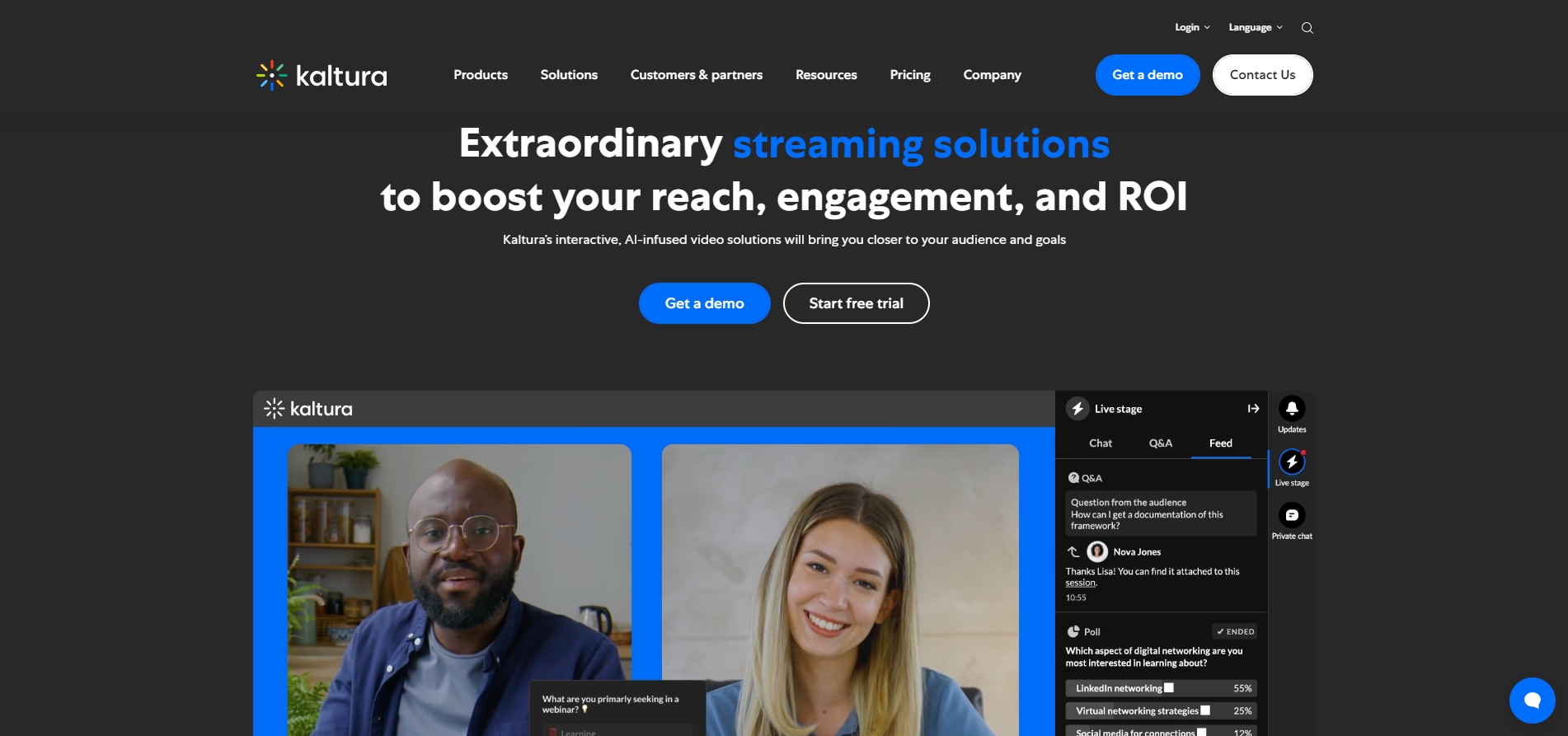
Kaltura is an enterprise-grade video platform that offers a wide range of video solutions, including live streaming, video hosting, and video management. Founded in 2006, Kaltura is particularly popular in the education, corporate, and media sectors for its customizable and scalable platform. Kaltura’s live streaming services are integrated with its video management tools, allowing organizations to create, manage, and deliver video content seamlessly. The platform offers advanced security features, comprehensive analytics, and strong integration with other enterprise tools. Kaltura’s open architecture also allows for extensive customization, making it adaptable to various use cases. Kaltura’s focus on flexibility, security, and scalability makes it a preferred choice for large organizations and institutions.
Pricing: Custom pricing based on requirements.
Pros:
- Robust security features and compliance with industry standards.
- Advanced analytics and reporting.
- Highly customizable and scalable.
- Strong integration with other enterprise tools and platforms.
Cons:
- Expensive, targeting enterprise clients rather than individual users.
- Complex setup and management requiring technical expertise.
- Less intuitive for beginners compared to simpler platforms.
5. Wowza
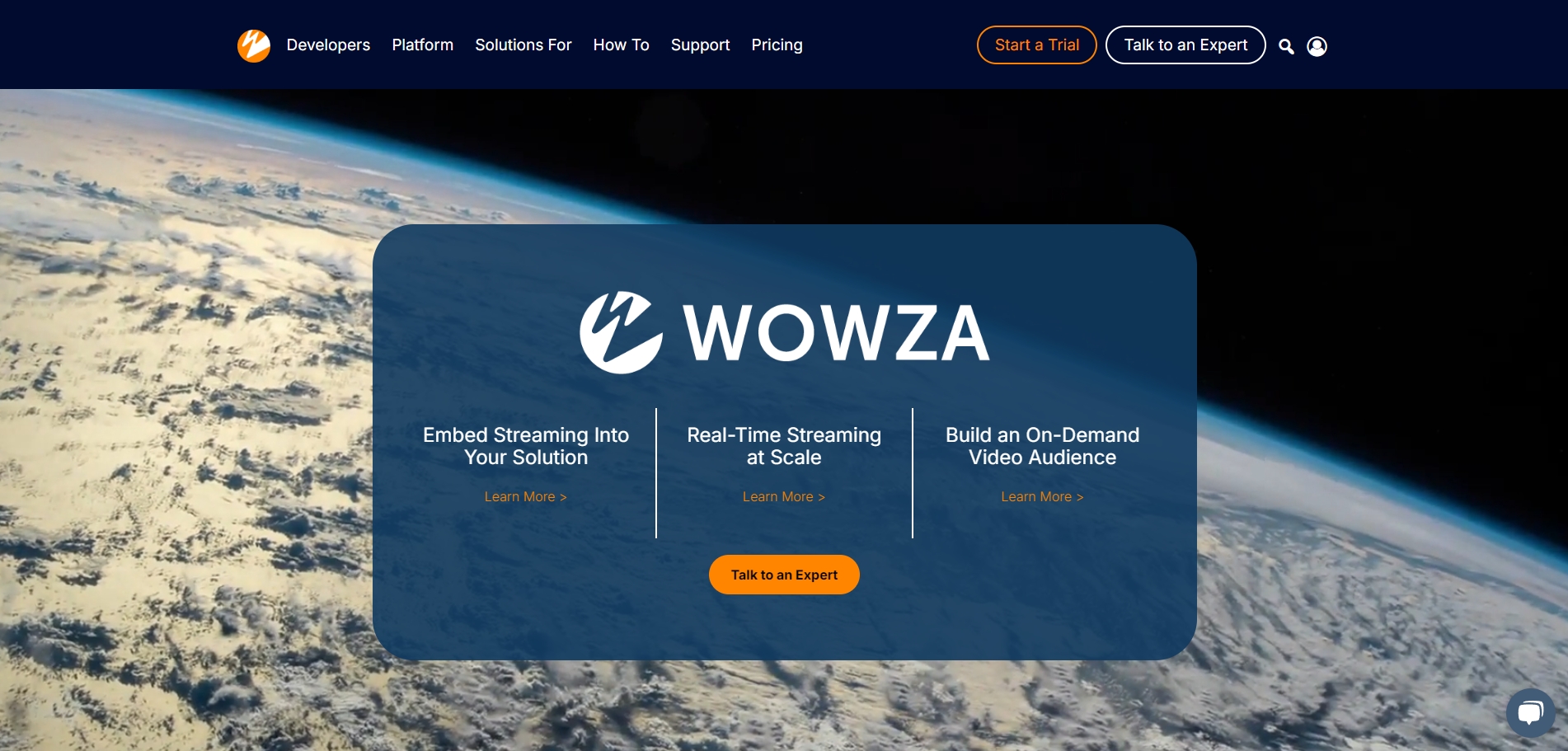
Wowza is a comprehensive streaming platform that provides both live and on-demand streaming services. Founded in 2005, Wowza is known for its high-performance streaming capabilities and support for multiple streaming protocols. The platform is designed for businesses, broadcasters, and developers who require a reliable and flexible streaming solution. Wowza offers low-latency streaming, adaptive bitrate streaming, and advanced customization options, making it suitable for a wide range of applications, from live events to surveillance. The platform also supports integration with various devices and third-party applications. With its focus on performance and flexibility, Wowza is a go-to solution for professionals who need a robust and scalable streaming platform.
Pricing: Starts at $99/month for the Basic plan.
Pros:
- High-quality streaming with low latency.
- Supports multiple streaming protocols and platforms.
- Advanced customization options for professional use.
- Scalable, making it suitable for small to large broadcasts.
Cons:
- Requires technical knowledge for setup and customization.
- Higher cost, geared toward businesses and professionals.
- Limited built-in monetization features.
6. Brightcove
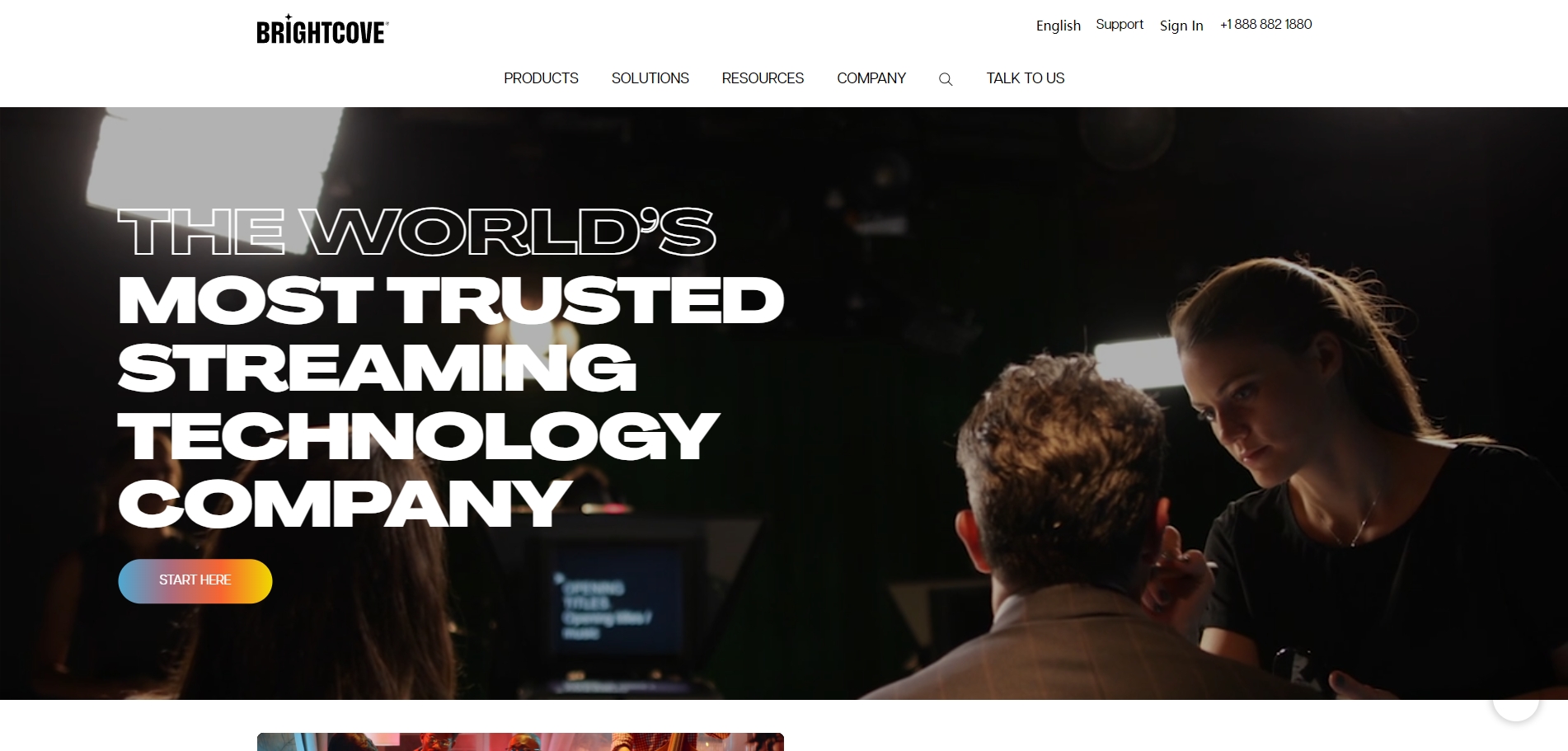
Brightcove is an enterprise-level video platform that provides a suite of video solutions, including live streaming, video hosting, and video monetization. Founded in 2004, Brightcove is known for its reliability, scalability, and advanced features, making it a popular choice among large corporations and media companies. Brightcove’s live streaming services are integrated with its video content management system, offering users a seamless experience from content creation to distribution. The platform includes advanced analytics, security features, and integration with marketing automation and CRM tools. Brightcove’s focus on enterprise clients means it offers extensive support and customization options, making it ideal for large-scale live streaming and video initiatives.
Pricing: Custom pricing based on requirements.
Pros:
- Enterprise-level security and compliance.
- Advanced analytics and viewer insights.
- Scalable and reliable for large broadcasts.
- Integration with marketing automation and CRM tools.
Cons:
- Expensive, designed for enterprise use.
- Requires technical expertise for optimal use.
- Less focus on community features or direct engagement compared to other platforms.
How to Choose Live Broadcasting Platforms?
Choosing the right live streaming platform depends on your specific needs, audience, and content type. For casual streamers or influencers, social media platforms like YouTube Live or Instagram Live offer easy access to existing followers and built-in monetization tools. Professional content creators or businesses might prefer paid platforms like Dacast or Vimeo Livestream, which provide advanced features and more control over the streaming experience. Consider factors like audience reach, ease of use, monetization options, and the level of technical support available when making your choice.
How to Live Stream to Multiple Platforms?
In today’s digital age, reaching your audience on just one platform might not be enough. Viewers are scattered across various social media networks, and maximizing your content’s visibility often requires a multi-platform approach. With BocaLive, you can not only stream live on multiple platforms at the same time, but also experience cutting-edge AI features:

- Customize unique AI avatars with personalized images and voices
- AI automatically creates appealing live stream scripts
- AI interacts with viewers by responding to comments in real-time
- A single computer can manage up to 6 live broadcast rooms
- Choose from over 100 ultra-realistic AI avatars, supporting 29+ languages
By using BocaLive, you not only save time and resources but also increase your content’s reach and impact. The platform’s advanced features make it the ideal choice for content creators who want to make the most of their live streams.
FAQs
Which platform is best for live streaming?
The best platform for live streaming depends on your content type and audience. For gaming, Twitch is the go-to platform, while YouTube Live offers versatility for various content types. For professional content, LinkedIn Live or Vimeo Livestream might be more suitable.
What are the most popular live streaming platforms?
The most popular live streaming platforms include YouTube Live, Twitch, Facebook Live, and Instagram Live, each catering to different audiences and content creators.
Is there a free live streaming platform?
Yes, platforms like YouTube Live, Twitch, Instagram Live, and Facebook Live are free to use, though they offer various monetization options that may involve revenue sharing.
Conclusion
Selecting the right live streaming platform is crucial for reaching and engaging your audience effectively. Whether you’re a casual streamer or a professional content creator, understanding the features, pros, and cons of each platform will help you make an informed decision. With the right tools, including multi-platform streaming solutions like BocaLive, you can enhance your streaming experience and expand your audience in 2024.




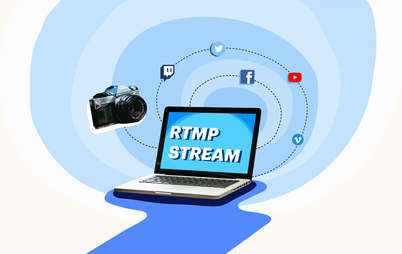
Recent Comments